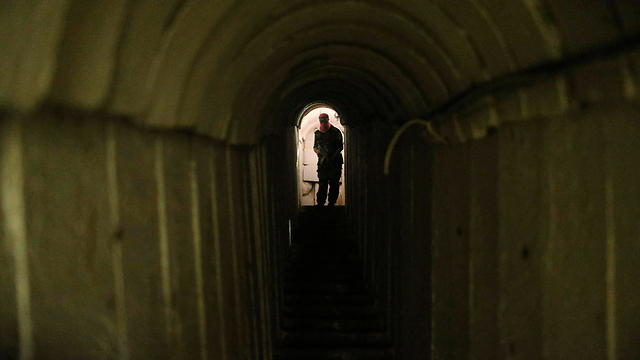

Between the lines, between the tunnels
Analysis: Dealing with the Hamas tunnel threat should have been part of the IDF’s defense plan vis-à-vis the Gaza Strip. So how is it possible that, according to what has been quoted from the state comptroller’s report on Operation Protective Edge, the army was unprepared for it?
An army does not have to wait for the political echelons to guide it on how to prepare for a for a defensive battle. Dealing with the threat of tunnels infiltrating Israeli territory should always have been part of the defense plan vis-à-vis the Gaza Strip.
So how is it possible that the IDF, according to what has been quoted from the state comptroller’s report on Operation Protective Edge, was unprepared to deal with the threat?
When the comptroller’s report is released this Tuesday, we should look for the paragraphs dealing with the Southern Command’s operative plans in the area of defense.
If it emerges that the comptroller discovered that dealing with the tunnels was not an integral part of the Southern Command’s defense plan on the eve of Protective Edge, then it was a faulty plan which requires the army to provide explanations.

Defense Minister Moshe Ya’alon and the top military officials assumed that Israel could deal with the tunnel threat efficiently from within its own territory: in other words, through intelligence and close physical monitoring of the tunnels’ exits.
This assumption stemmed from, among other things, the evaluation that both Hamas and Israel had no interest in a comprehensive conflict. The army presented retrospective evidence to illustrate the point, stating that apart from one tunnel from which terrorists infiltrated Israel and killed five soldiers from the company commanders’ school, the rest of the breaches were ultimately uncovered, and not a single civilian was hurt.
This perception of the defense minister and top military echelons on the eve of Operation Protective Edge was reflected in the IDF’s preparedness for the operation. Rather than preparing for a physical takeover of some 30 tunnels, they prepared to uncover the tunnels and deal with them from within Israeli territory.
In this case too, we should look carefully between the lines of the comptroller’s report.
When the army received an order from the political echelon shortly before launching Protective Edge to change the plans and prepare for a comprehensive military operation, which entailed capturing the tunnels within the Gaza Strip, did any of the officers stand up and say: “Gentlemen, we are not prepared for such an operation. We have neither the equipment nor the professionals, the training or the combat doctrine”? Did the defense minister say that to the cabinet?
Another thing that has to be looked into carefully between the lines of the report pertains to what intelligence the army had when it reached the fighting in the tunnel.
Who was actually responsible for providing the intelligence? Was there an organized, structured and clear division of work regarding the person responsible for essential elements of information on the Gaza issue? Was it the Military Intelligence Directorate? The Shin Bet? The South Command intelligence? Did everyone deal with everything in an improvised fashion, without any coordination between them?
And in general, what was the extent of the intelligence effort dedicated to the tunnels? Did the Marmara story repeat itself, when the Military Intelligence Directorate, the Navy and the Mossad were not on the same page, and blamed each other in retrospect as a result?
When the army wants to thwart a plan, it knows how to do so very well. Officers have already faced the cabinet in the past and explained why Israel was not prepared to strike in Iran. The main argument at the time, on a side note, was not operational inability but rather the number of casualties which the State of Israel would not be able to endure. The cabinet was convinced.
In the case of the tunnels—which was part of a much more certain conflict than the conflict with Iran—there was probably not a single military official who stood up and said: Gentlemen, not only are we not prepared, we cannot know just how many casualties there may be. The proof lies in the defense minister’s initial version that taking over the tunnels would be a matter of a mere two days.
Was the National Security Council aware of the military echelon’s level of preparedness for dealing with the tunnels? I wonder what the state comptroller would have written about that. It seems that it was not only the cabinet which did not receive full reports and did not show an interest as it should have. The National Security Council, a passive player for years now, acted no differently either.
Knesset Member Ofer Shelah (Yesh Atid), who investigated Operation Protective Edge as part of the Knesset’s Foreign Affairs and Defense Committee, determined that the IDF, as described in the Winograd Commission’s report in 2006, was unprepared for the Second Lebanon War.
And the IDF, as described in the 2017 comptroller’s report, was unprepared for the evolving conflict which led to Operation Protective Edge.
Eleven years have passed between the two reports, and the result is almost identical. Is this a coincidence?
















